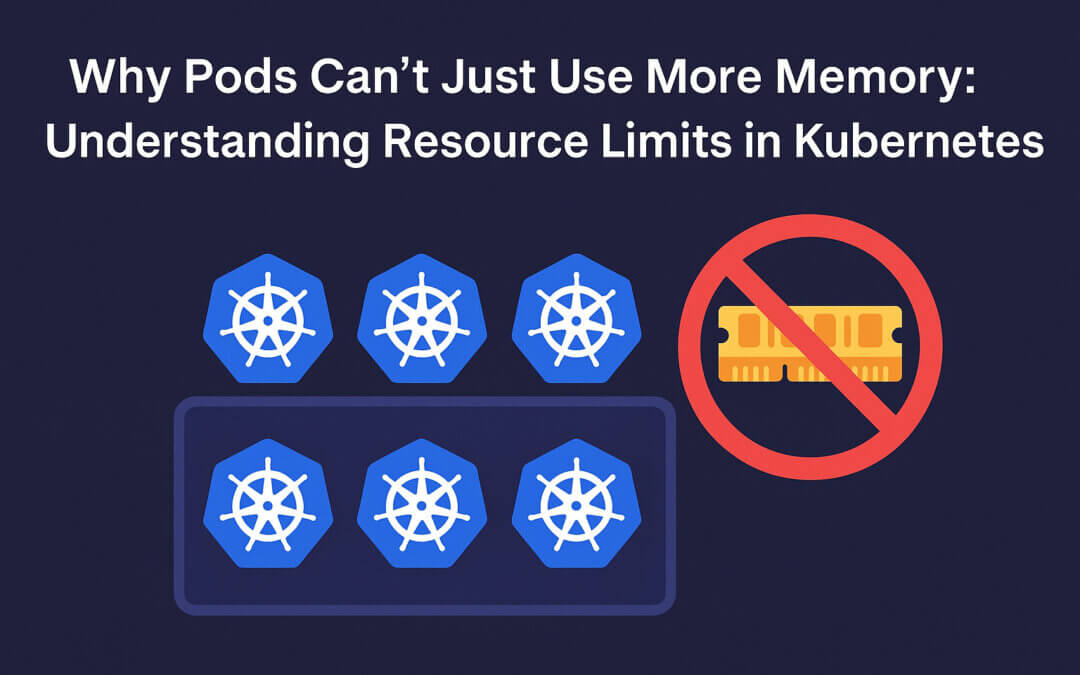Kubernetes has revolutionized the way we deploy, scale, and manage containerized applications. It abstracts infrastructure, automates scheduling, and enables dynamic scaling. But with great power comes the need for careful planning—especially when it comes to managing memory and CPU resources.
One of the most misunderstood concepts in Kubernetes, especially among newcomers, is the idea that a container or Pod can simply use more memory as needed. In traditional computing environments, applications often run on virtual machines with plenty of headroom, and memory overcommitment is handled leniently. But Kubernetes takes a much stricter, cloud-native approach. Containers are tightly scoped, and once memory limits are in place, those limits are enforced absolutely.
Let’s dive into why Kubernetes imposes these boundaries, what happens when they’re exceeded, and how to design your workloads for resilience and predictability.
How Kubernetes Defines Resource Boundaries
In Kubernetes, each container within a Pod can be configured with two memory-related parameters: a request and a limit.
The request defines the minimum amount of memory that a container needs to run reliably. This value is used by the Kubernetes scheduler to decide which Node can accommodate the Pod. If a Pod requests 512 megabytes of RAM, for example, it will only be scheduled on a Node that has at least that amount of free memory available.
The limit, on the other hand, defines the maximum amount of memory the container is allowed to consume. This is a hard cap. If the container attempts to use more memory than this limit, it doesn’t get throttled—it gets terminated.
These values are not soft suggestions. They’re enforced using Linux control groups (cgroups), which allow the operating system to apply strict boundaries on memory and CPU usage per process or container.
What Happens When a Pod Uses Too Much Memory
If a container inside a Pod tries to allocate more memory than its configured limit, Kubernetes doesn’t merely restrict it—it terminates the container. This is because memory is not a compressible resource. The container gets killed by the OOM Killer, a Linux kernel mechanism designed to free up memory under critical pressure.
In Kubernetes terms, the Pod’s status will reflect this with a termination reason labeled OOMKilled. This might occur during a spike in traffic, a memory leak, or simply a misconfigured application that exceeds its bounds.
The container may restart if the Pod’s restart policy allows it, but repeated OOMKills often indicate a deeper problem in memory sizing or application behavior.
Why You Must Set Memory Limits
It might be tempting to run containers without memory limits, especially during development. After all, why restrict flexibility? The answer lies in the shared nature of Kubernetes clusters.
Without memory limits, a single misbehaving Pod could consume all available memory on its Node, starving other Pods of resources and potentially crashing critical services. Worse, it might render the Node itself unresponsive, forcing you to reboot or even replace it.
Setting memory limits ensures that:
- No container can monopolize the Node’s memory.
- Applications are forced to behave within predictable boundaries.
- The cluster remains stable, even under high load or unexpected behavior.
This is a foundational principle of cloud-native design: containers are disposable and constrained by design.
Managing Resource Usage Across the Cluster
Beyond setting limits for individual Pods, Kubernetes provides tools to manage memory consumption at the namespace level. Two of the most useful are LimitRanges and ResourceQuotas.
A LimitRange sets default memory requests and limits for containers within a namespace. This ensures that even if a developer forgets to define them, the cluster imposes sensible defaults.
A ResourceQuota, on the other hand, enforces a cap on the total memory or CPU usage across all Pods in a namespace. This prevents any one team, service, or application from overwhelming shared infrastructure.
Combined, these tools help organizations scale safely, enforce policies, and maintain a fair allocation of resources across teams.
Monitoring and Observability Are Crucial
Setting limits is only one half of the equation. Monitoring how close your Pods come to those limits is equally important. Without observability, you won’t know whether your services are consistently nearing termination thresholds or running with excess unused resources.
Kubernetes-native tools like Prometheus and Grafana, or managed services like Datadog and New Relic, provide visibility into container-level memory consumption. These insights help teams fine-tune their requests and limits, optimizing for cost, performance, and reliability.
It’s also important to investigate any OOMKilled events, understand what caused them, and adjust limits or application behavior accordingly.
Conclusion: Plan for Limits, Design for Stability
Kubernetes was built for efficiency, scalability, and resilience. At the heart of this model is the assumption that workloads must declare their resource needs—and that those needs are strictly enforced.
Containers cannot exceed their memory limits. If they try, they are terminated without exception. This can come as a surprise to developers who are new to container orchestration, but it’s a deliberate design choice that protects the system as a whole.
To build robust, scalable systems in Kubernetes, you must understand and properly configure memory requests and limits. Treat them not as obstacles, but as guarantees—contractual boundaries that make your applications predictable and your infrastructure stable.
Because in Kubernetes, more memory isn’t just a wish—it’s something you plan for.

